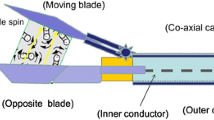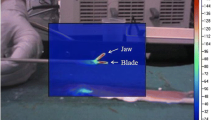Abstract
Background
Ultrasonically activated devices (USADs) offer excellent coagulating dissection performance and are broadly used, particularly in endoscopic operations. Traditional USADs, however, have fixed linear shape and are thus limited in the directions from which organs can be approached. We have developed a small USAD transducer attached to the tip of an articulating device, offering a new kind of USAD in which the tip can bend as desired. We describe herein an evaluation of the coagulating dissection performance of this new articulating USAD and an in vivo confirmation of clinical usefulness.
Methods
To evaluate coagulating dissection performance, we compared coagulating shearing on porcine splenic arteries between the articulating USAD and a Harmonic Scalpel II (HSII), representing a traditional USAD. Changing the amplitude of vibration between 60 μm and 80 μm and grip force among 1, 2, and 3 N, we measured the time required for division and bursting pressure of coagulating dissection. An in vivo experiment in a pig was also used to confirm the usefulness of the articulating USAD in laparoscopic operations.
Results
Division time did not differ significantly between the articulating USAD and HSII with an 80-μm amplitude of vibration and a grip force of 2 or 3 N. Bursting pressure of blood vessels showed no significant difference between articulating USAD and HSII under all experimental conditions. In the in vivo experiment, the new bendable tip of the articulating USAD displayed coagulating dissection performance equivalent to that of the traditional USAD.
Conclusions
We have developed a new articulating USAD that can broaden the range of methods and approaches available for USADs and improve usefulness and safety.







Similar content being viewed by others
References
Amaral JF (1994) The experimental development of an ultrasonically activated scalpel for laparoscopic use. Surg Laparosc Endsc 4:92–99
Amaral JF (1995) Laparoscopic cholecystectomy in 200 consecutive patients using an ultrasonically activated scalpel. Surg Laparosc Endosc 5:255–262
Msika S, Deroide G, Kianmanesh R, Iannelli A, Hay JM, Fingerhut A, Flamant Y (2001) Harmonic scalpel in laparoscopic colorectal surgery. Dis Colon Rectum 44:432–436
Kanehira E, Omura K, Miyanaga T, Mori A, Kinoshita T, Watanabe Y (1997) Basic experiments to evaluate safety of the 55.5 kHz ultrasonically activated instrument and its application in laparoscopic gastric surgery. J Jpn Soc Endosc Surg 2:239–244
Cherqui D, Husson E, Hammoud R, Malassagne B, Stephan F, Bensaid S, Rotman N, Fagniez PL (2000) Laparoscopic liver resections: a feasibility study in 30 patients. Ann Surg 232:753–762
Melzer A, Kipfmuller K, Halfar B (1997) Deflectable endoscopic instrument system DENIS. Surg Endosc 11:1045–1051
Kanehira E, Kinoshita T, Omura K (1999) Ultrasonically-activated devices for endoscopic surgery. Ther Allied Technol 8:89–94
Hashimoto M, Bandoh K, Wakako R (2005) Development of ultrasonically activated bending scalpel using a link mechanism. In: Proceedings of the 2002 IEEE/RSJ international conference on intelligent robots and systems, pp 1415–1420
Kanehira E, Omura K, Kinoshita T, Kawakami K, Watanabe Y (1999) How secure are the arteries occluded by a newly developed ultrasonically activated device? Surg Endosc 13:340–342
Falcone T, Goldberg JM (2003) Robotic surgery. Clin Obstet Gynecol 46(1):37–43
Ninomiya K, Kitano S, Yoshida T, Bandoh T, Baatar D, Matsumoto T, Tsuboi S (2000) The efficacy of laparosonic coagulating shears for arterial division and hemostasis in porcine arteries. Surg Endosc 14:131–133
Abe K, Terashima M, Fujiwara H, Takagane A, Uesugi N, Saito K (2005) Experimental evaluation of bursting pressure in lymphatic vessels with ultrasonically activated shears. World J Surg 29(1):106–109
Acknowledgements
The authors would like to thank Drs. Ichiro Sakuma, Etsuko Kobayashi, Takashi Suzuki, and Mr. Takeshi Hasuo (The University of Tokyo) for technical support. This study was partly supported by a Grant for Child Health and Development (16-c3) from the Ministry of Health, Labour and Welfare, and a research grant from Sapporo Bioscience Foundation.
Author information
Authors and Affiliations
Corresponding author
Rights and permissions
About this article
Cite this article
Ogura, G., Nakamura, R., Muragaki, Y. et al. Development of an articulating ultrasonically activated device for laparoscopic surgery. Surg Endosc 23, 2138–2142 (2009). https://doi.org/10.1007/s00464-008-0248-7
Received:
Accepted:
Published:
Issue Date:
DOI: https://doi.org/10.1007/s00464-008-0248-7




